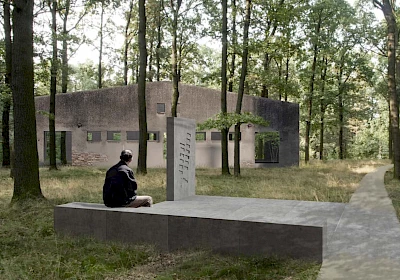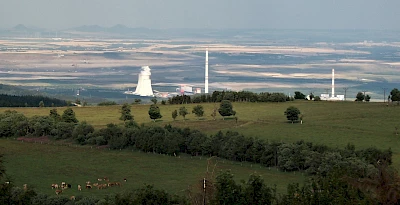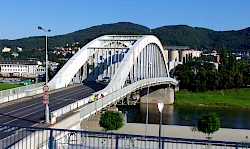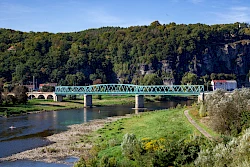Weekly review no. 30
26.04.2024
Roma memorial Lety opens

A memorial to the Porajmos, the genocide of the Roma under National Socialism, was opened in Lety in southern Bohemia. Both President Petr Pavel and Prime Minister Petr Fiala spoke at the inauguration ceremony. The memorial, which will be open to the public from May 12, commemorates a concentration camp that was set up here for Roma from the Czech Republic during the years of National Socialist occupation. A labor camp primarily for Roma had previously stood on the same site.
After 1945, the place was forgotten, and later a pig farm was built. Since the Velvet Revolution, there have been efforts - also encouraged by the then President Václav Havel - to set up a reverent place of remembrance. But the respective governments refused to close the pig farm. For a long time, the government did not want to acknowledge that the Roma had been genocide, let alone that it was its own fault. This lack of interest was also due to the fact that Roma in the Czech Republic still have only a small lobby and are largely socially excluded.
It was not until 2018 that the state agreed to buy the pig farm. In 2022, the demolition was completed and construction of the memorial could begin. It is affiliated with the Museum of Roma Culture in Brno.
1,308 Roma, both old and children, men and women, were held in the camp between August 1942 and May 1943, 327 died and over 500 were murdered in concentration camps. In Hodonín u Kunštátu in Moravia there was a second camp that served as a holiday camp after 1945. A small memorial had already been set up there. You can find out more about the history of the camp in Lety at www.holocaust.cz .
New location for Czech lithium production
The lithium in the Ore Mountains has also created a gold rush atmosphere in the Czech Republic. The raw material is to be mined in the old mining town of Cínovec. The Czech Republic hopes that this will give it independence from the world market in this important area and enable it to move into the technological forefront. But not much has happened for years. The Geomet company was taken over by the majority state-owned energy company ČEZ. But mining is still a long way off.

Now Geomet has even had to accept a setback. Due to protests from local residents, the company gave up the desired location for the lithium processing plant in the town of Újezdeček, south of Dubí, and decided to build the plant in Prunéřov, west of Chomutov.
Residents had been protesting against the plant in Újezdeček for two years. The residents of the small settlement of Dukla in particular were afraid of the plant, which would have bordered on their property. For two years they fought a David versus Goliath battle. Geomet always claimed that Újezdeček was the best location. Criticism from district administrator Jan Schiller was certainly crucial to the success of the protest. Other regional and local politicians also sided with the residents. Geomet was repeatedly criticized for its information policy.
Now the residents of the Dukla settlement can celebrate. Geomet now wants to transport the mined lithium to Prunéřov by train. Újezdeček is only planned as a transfer point for the ore to the railway. There is a ČEZ coal-fired power plant in Prunéřov. Geomet wants to locate both the mechanical and chemical processing of lithium there. Up to 60 lithium trains per week are planned from Újezdeček to Prunéřov.
When lithium mining will begin in the Czech Ore Mountains is still up in the air. A feasibility study, which was supposed to be available at the end of 2023, has not yet been completed. The only thing that is certain is that mining will take place underground. The transport of the ore from the shaft to the transshipment point in Újezdeček is also still an open question. Most recently, two options were considered: a transport lift or a conveyor belt. Geomet plans to mine over 2 million tons of ore per year, which will be processed into around 25,000 tons of lithium.
Žatec wins another title
A year ago, the hop town of Žatec was left empty-handed. Then, on September 18, it was added to the UNESCO World Heritage List. Exactly seven months later, Žatec was also named a "Historic Town of the Czech Republic." The town was thus recognized for its long-term, successful renovation of the historic town center and individual buildings. The jury particularly emphasized that, in addition to using state funding, the town also succeeds in motivating private homeowners to carry out renovations in accordance with the monument's preservation requirements.
Žatec won the coveted title at the eighth attempt. The winners in each district always make it to the final. Žatec won the Ústí district for the eighth time in a row in 2023. The nationwide winner will receive 1 million crowns (40,000 euros) for monument preservation.
New Elbe bridges for pedestrians and cyclists

Construction of a new bridge for pedestrians and cyclists has begun in Ústí. The new Elbe crossing is being built downstream of the Beneš Bridge. It is a temporary solution for the period of the renovation of the Beneš Bridge. The temporary solution is to be three meters wide and to be completed by next winter. All supply lines that currently run over the Beneš Bridge will also be diverted over the temporary bridge. The long-overdue renovation of the Beneš Bridge is to be completed in October 2026.

A bridge for pedestrians and cyclists is also being built in Děčín. It will be built onto the railway bridge. Unlike the one in Ústí, however, it will not be a temporary bridge, but will make it easier for pedestrians and cyclists to cross. In future, this will also make crossing the Elbe easier for all those who are using the Elbe cycle path. Until now, they had to take the inconvenient route over the Tyrš Bridge.
 The production of this newsletter is co-financed by tax revenue on the basis of the budget approved by the Saxon State Parliament.
The production of this newsletter is co-financed by tax revenue on the basis of the budget approved by the Saxon State Parliament.
